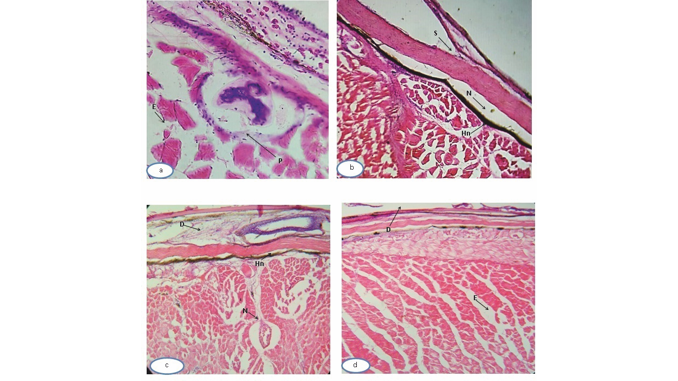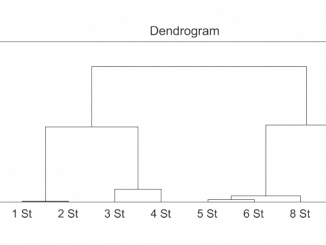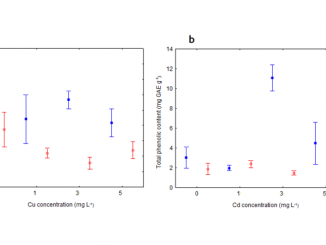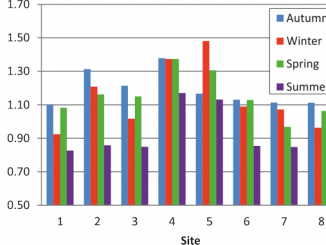
Paper category: Original research paper
Corresponding author: Mohamed E. Goher (smgoher@yahoo.com)
DOI: 10.1515/ohs-2020-0020
Received: 12/01/2020
Accepted: 23/03/2020
Full text: here
Citation (APA style): Oceanological and Hydrobiological Studies, Volume 49, Issue 3, Pages 215–229, eISSN 1897-3191, ISSN 1730-413X, DOI: https://doi.org/10.1515/ohs-2020-0020.
Abstract
Research on the impact of heavy metals and their accumulation in ecosystem elements of Lake Burullus is still scarce. Therefore, this study focuses on the relationship between the levels of heavy metals in the lake water, plankton communities and Nile tilapia (Oreochromis niloticus). The mean annual concentrations of Fe, Zn, Cu, Mn, Pb and Cd in water and fish samples were 527.8, 366.7, 162.6, 137.3, 119.8 and 3.6 μg l−1, and 70.8, 43.6, 8.05, 1.2, 0.14 and 0.045 µg g−1 dry weight (d.w.), respectively. The study demonstrated the relationship between the accumulation of metals in fish muscles and their levels in the lake water (p < 0.05; r = 0.7–0.9), with the metal content in O. niloticus muscles being mostly below the permissible limits. The obtained results showed that the levels of the metals in the lake water are not correlated with phytoplankton and zooplankton, and their groups, except copper and zinc, are negatively correlated with phytoplankton (r = −0.45 and −0.58, respectively). The study concluded that the concentrations of the analyzed metals in Lake Burullus did not reach the effective levels that would have a significant impact on the distribution of phytoplankton and zooplankton, or a hazardous effect on O. niloticus and its safety for human consumption.
References
Abou El-Gheit, E.N., Abdo, M.H. & Mohmoud, S.A. (2012). Impact of blooming phenomenon on water quality and Fishes in Qarun Lake. Egypt. International Journal of Environmental Science and Engineering (IJESE) 3: 11–23.
Abouel Fadl, K.Y., Aly, W., Abd El-Reheem, A.E., Mahmoud, U.M., Hamed, H.S. et al. (2016). Heavy metals levels in the blood of Oreochromis niloticus niloticus and Clarias gariepinus as biomarkers of metal pollution in the River Nile. Int. J. Ecotoxico.l Ecobiol. 1: 1–12.
Adeyeye, E., (1993). Trace heavy metals distribution in Illisha africana (Block) fish organs and tissue. I: lead and cadmium. Ghana Journal of Chemistry 1: 377–384.
Adeyeye, E.I., Akinyugha, N.J., Fesobi, M.E. & Tenabe, V.O. (1996). Determination of some metals in Clarias gariepinus (Cuvier and Vallenciennes), Cyprinus carpio (L.) and Oreochromis niloticus (L.) fishes in a polyculture fresh water pond and their environments. Aquaculture 147(3–4): 205–214.
Ahmed, N.A.M. (2012). Biochemical studies on pollution of the River Nile at different stations of Delta barrage (Egypt). Unpublished doctoral dissertation. Agric. Fac., Benha, Egypt.
Alinnor, I.J. & Obiji, I.A. (2010). Assessment of trace metal composition in fish samples from Nworie River. Pakistan Journal of Nutrition 9(1): 81–85.
Anufriieva, E.V., Goher, M.E., Hussian, A.M., El-Sayed S.M., Hegab, M.H. et al. (2020). Ecosystems of artificial saline lakes. A case of Lake Magic in Wadi El-Rayan depression (Egypt). Knowl. Manag. Aquat. Ecosyst. 421: 31. DOI: 10.1051/kmae/2020024.
APHA (2005). American Public Health Association, Standard Methods for the Examination of Water and Wastewater. 21st Ed., Washington, DC, USA.
Arunakumara, K.K.I.U. & Zhang, X. (2008). Heavy metal bioaccumulation and toxicity with special reference to microalgae. Journal of Ocean University of China 7(1): 60–64.
Assar, W., Elshemy, M. & Zeidan, B. (2015). Water quality modeling for Burullus Lake, Egypt, Part I: Model calibration. Mansoura Eng. J. 40(2): 8.
Bahnasawy, M., Khidr, A.A. & Dheina, N. (2009). Assessment of heavy metals concentrations in water, plankton and fish of Lake Manzala, Egypt. Egyptian Journal of Aquatic Biology and Fisheries 13(2): 117–133.
Bahnasawy, M., Khidr, A.A. & Dheina, N. (2011). Assessment of heavy metal concentrations in water, plankton, and fish of Lake Manzala, Egypt. Turkish Journal of Zoology 35(2): 271–280.
Beheary, M, Serag, M.S., Basiony, A.I.& El-Moselhy, K. (2014). The current status of heavy metals pollution in Burullus Protectorate, Ramsar site, Egypt. J. Egypt. Acad. Soc. Environ. Dev. 15: 9–20.
Bernet, D., Schmidt, H., Meier, W., Burkhardt‐Holm, P. & Wahli, T. (1999). Histopathology in fish: proposal for a protocol to assess aquatic pollution. Journal of Fish Diseases 22(1): 25–34.
Bilgrami, K.S. & Kumar, S. (1997). Effects of copper, lead and zinc on phytoplankton growth. Biologiaplantarum 39(2): 315–317.
Brand, L.E., Sunda, W.G. & Guillard, R.R. (1983). Limitation of marine phytoplankton reproductive rates by zinc, manganese, and iron. Limnology and Oceanography 28(6): 1182–1198.
Buikema, Jr, A.L., Cairns Jr, J. & Sullivan, G.W. (1974). Evaluation of Philodina acuticornis (Rotifera) as a bioassay organism for heavy metals. Journal of the American Water Resources Association 10(4): 648–661.
Chen, C.Y., Stemberger, R.S., Klaue, B., Blum, J.D., Pickhardt, P.C. et al. (2000). Accumulation of heavy metals in food web components across a gradient of lakes. Limnology and Oceanography 45(7): 1525–1536.
Chen, Z., Salem, A., Xu, Z. & Zhang, W. (2010). Ecological implications of heavy metal concentrations in the sediments of Burullus Lagoon of Nile Delta, Egypt. Estuarine, Coastal and Shelf Science 86(3): 491–498.
Chouteau, C., Dzyadevych, S., Chovelon, J.M. & Durrieu, C. (2004). Development of novel conductometric biosensors based on immobilised whole cell Chlorella vulgaris microalgae. Biosensors and Bioelectronics 19(9): 1089–1096.
D’Alelio, D., Libralato, S., Wyatt, T., & d’Alcalà, M.R. (2016). Ecological-network models link diversity, structure and function in the plankton food-web. Scientific Reports. 6, 21806.
Daviglus, M., Sheeshka, J. & Murkin, E. (2002). Health benefits from eating fish. Comments on Toxicology 8(4–6): 345–374.
De Philippis, R., Colica, G. & Micheletti, E. (2011). Exopolysaccharide-producing cyanobacteria in heavy metal removal from water: molecular basis and practical applicability of the biosorption process. Applied Microbiology and Biotechnology 92(4): p. 697.
Dumont, H.J. & El-Shabrawy, G.M. (2007). Lake Borullus of the Nile Delta: a short history and an uncertain future. AMBIO: A Journal of the Human Environment 36(8): 677–682.
Dunne, J.A., Williams, R.J. & Martinez, N.D. (2004). Network structure and robustness of marine food webs. Marine Ecology Progress Series 273: 291–302.
Eiaas M.A. (2019). Studies of nitrogen and phosphorus species on Lake Burullus water. Unpublished doctoral dissertation. Fac. of Sci., Menofia Univ., Egypt. 277p.
El Baz, S.M. (2015). Benthic foraminifera as bioindicators of heavy metal pollution in Lake Burullus, Egypt. Arabian Journal of Geosciences 8(8): 5491–5509.
El Sayed, F.A., Okbah, M.A., El-Sayed, M.S., Eissa, M.A. & Goher, M.E. (2019). Nutrient Salts and Eutrophication Assessment in Northern Delta Lakes: Case study Burullus Lake, Egypt. Egyptian Journal of Aquatic Biology and Fisheries 23(2): 145–163.
El Sayed, S.M., Hegab, M.H., Mola, H.R.A. Ahmed, N.A. & Goher M.E. (2020). An integrated water quality assessment of Damietta and Rosetta branches (Nile River, Egypt) using chemical and biological indices. Environ Monit. Assess. 192: 228. DOI: 10.1007/s10661-020-8195-4.
El-Adawy, A., Negm, A.M., Elzeir, M.A., Saavedra, O.C., El-Shinnawy, I.A. et al. (2013). Modeling the hydrodynamics and salinity of el-Burullus Lake (Nile Delta, northern Egypt). Journal of Clean Energy Technologies 1(2): 157–163.
El-Amier, Y.A., Elnaggar, A.A. & El-Alfy, M.A. (2017). Evaluation and mapping spatial distribution of bottom sediment heavy metal contamination in Burullus Lake, Egypt. Egyptian Journal of Basic and Applied Sciences 4(1): 55–66.
El-Batrawy, O.A., El-Gammal, M.I., Mohamadein, L.I., Darwish, D.H. & El-Moselhy, K.M. (2018). Impact assessment of some heavy metals on tilapia fish, Oreochromis niloticus, in Burullus Lake, Egypt. The Journal of Basic and Applied Zoology 79 13(2018). DOI: 10.1186/s41936-018-0028-4.
El-Sayed, S. (2011). Physicochemical studies on the impact of pollution up on the River Nile branches, Egypt. Unpublished M.Sc. dissertation. Faculty of Science, Benha University, Egypt.
El-Shabrawy G.M. & Bek M.A. (2018). Responses of Zooplankton to Long-Term Environmental Changes in the Egyptian Coastal Lakes. In The Handbook of Environmental Chemistry. Springer, Berlin, Heidelberg
EL-Zeiny, A. & EL-Kafrawy, S. (2016). Assessment of water pollution by human activities in Burullus lake using Landsat 8 operational land imager and GIS. The Egyptian Journal of Remote Sensing and Space Science 20(1): S49–S56. DOI: 10.1016/j.ejrs.2016.10.002.
Escribano, R. & Hidalgo, P. (2000). Spatial distribution of copepods in the north of the Humboldt Current region off Chile during coastal upwelling. Journal of the Marine Biological Association of the United Kingdom 80(2): 283–290.
European Food Safety Authority (EFSA). (2005). Opinion of the Scientific Panel on Dietetic Products, Nutrition and Allergies (NDA) on a request from the Commission related to the Tolerable Upper Intake Level of Fluoride. EFSA Journal 3(3): 192.
FAO. (1992). Committee for inland fisheries of Africa: Working Party on Pollution and Fisheries. FAO Fish. Rep., No. 471.
GAFRD. (2018). Fish production statistics of Egypt in 2016 (26st edition). General Authority for Fishery Resources Development. Ministry of Agriculture, Cairo.
Gagneten, A.M. & Paggi, J.C. (2009). Effects of heavy metal contamination (Cr, Cu, Pb, Cd) and eutrophication on zooplankton in the lower basin of the Salado River (Argentina). Water, Air, and Soil Pollution 198(1–4): 317–334.
Ghabour, T.K., Rahim, I.S. & Morgan, R.S. (2013). Heavy metals status of some wetlands of Egypt. J Appl. Sci. Res. 9(7): 4345–4350.
Goher M.E., Ali M.H.H. & El-Sayed, S.M. (2019). Heavy metals contents in Nasser Lake and the Nile River, Egypt: An overview. Egyptian Journal of Aquatic Research 45(4): 301–312. DOI: 10.1016/j.ejar.2019.12.002.
Goher, M.E. (2002). Chemical studies on the precipitation and dissolution of some chemical element in Lake Qarun. Unpublished doctoral dissertation. Faculty of Science, Al- Azhar University, Cairo, Egypt. 259 p.
Goher, M.E., Abdo, M.H., Bayoumy, W.A. & Mansour, T.Y. (2017). Some heavy metal contents in surface water and sediment as a pollution index of El-Manzala Lake. Egypt. J. Basic Environ. Sci. 2: 210–225.
Goher, M.E. (2009). Chemical assessment of water quality and some heavy metals in Lake Burullus (Egypt). J. Egypt. Acad. Soc. Environ. Develop. 10(4): 123–138.
Goher, M.E., Abdo, M.H., Mangood, A.H. & Hussein, M.M. (2015). Water quality and potential health risk assessment for consumption of Oreochromis niloticus from El-Bahr El-Pharaony Drain, Egypt. Fresenius Environ. Bull. 24(11): 3590–3602.
Goldberg, E.D., Koide, M., Hodge, V., Flegel, A.R. & Martin, J.U. (1963). Mussel water: 1977–1978 results on trace metals and radionuclides. Estuar. Coastal Shelf Sci. (16): 69–93.
Imam, N., El-Sayed, S.M. & Goher, M.E. (2020). Risk assessments and spatial distributions of natural radioactivity and heavy metals in Nasser Lake, Egypt. Environ. Sci. Pollut. Res. 27: 25475–25493. DOI: 10.1007/s11356-020-08918-7.
Järup, L. (2003). Hazards of heavy metal contamination. British Medical Bulletin 68(1): 167–182.
Jewett, S.C. & Sathy Naidu, A. (2000). Assessment of heavy metals in red king crabs following offshore placer gold mining. Mar. Pollut. Bull. 40(6): 478–490.
Kennish, M.J. & Paerl, H.W. (2010). Coastal lagoons: critical habitats of environmental change. CRC Press.
Kimmel, D.G., Roman, M.R. & Zhang, X. (2006). Spatial and temporal variability in factors affecting mesozooplankton dynamics in Chesapeake Bay: evidence from biomass size spectra. Limnology and Oceanography 51(1): 131–141.
Kleppel, G.S. (1993). On the diets of calanoid copepods. Marine Ecology Progress Series 99: 183–195.
Kotze, P.D., Preez, H.H. & Van-Vuren, J.H.J. (2006). Bioaccumulation of copper and Zinc in Oreochromis mossambicus and Clarias gariepinus, from the Olifants River, Mpumalanga, South Africa. Water SA 25(1): 99–110.
Krupińska, I. (2017). Effect of organic substances on the efficiency of Fe (II) to Fe (III) oxidation and removal of iron compounds from groundwater in the sedimentation process. Civil and Environmental Engineering Reports 26(3): 15–29.
Landers, J.E. (2016). Aquatic food webs and heavy metal contamination in the upper Blackfoot River, Montana. Graduate Student Theses, Dissertations, & Professional Papers 10719.
Li, L., Zheng, B. & Liu, L. (2010). Biomonitoring and bioindicators used for river ecosystems: definitions, approaches and trends. Procedia Environmental Sciences 2: 1510–1524.
Lougheed, V.L. & Chow-Fraser, P. (2002). Development and use of a zooplankton index of wetland quality in the Laurentian Great Lakes basin. Ecological Applications 12(2): 474–486.
Mansour, S.A. & Sidky, M.M. (2002). Ecotoxicological studies. 3. Heavy metals contaminating water and fish from Fayoum Governorate, Egypt. Food Chemistry 78(1): 15–22.
Marks, P.J., Plaskett, D., Potter, I. & Bradly, J. (1980). Relationship between concentration of heavy metals in muscle tissues and body weight of fish from the Swan-Avon estuary, Western Australia. Australian Journal of Marine and Freshwater Research 31: 783–793.
Masoud, M.S., Fahmy, M.A., Ali, A.E. & Mohamed, E.A. (2011). Heavy metal speciation and their accumulation in sediments of Lake Burullus, Egypt. African Journal of Environmental Science and Technology 5(4): 280–298.
Melegy, A.A., El-Bady, M.S. & Metwally, H.I. (2019). Monitoring of the changes in potential environmental risk of some heavy metals in water and sediments of Burullus Lake. Egypt Bulletin of the National Research Centre 43 143(2019). DOI: 10.1186/s42269-019-0182-y.
Mohamed, F.A.S. (2008). Bioaccumulation of Selected Metals and Histopathological Alterations in Tissues of Oreochromis niloticus and Lates niloticus from Lake Nasser, Egypt. Global Veterinaria 2(4): 205–218.
Mohiuddin, K.M. Ogawa, Y.Z.H.M., Zakir, H.M., Otomo, K. & Shikazono, N. (2011). Heavy metals contamination in water and sediments of an urban river in a developing country. International Journal of Environmental Science & Technology 8(4): 723–736.
Muduli, P.R., Vardhan, K.V., Ganguly, D., Abhilash, K.R. & Balasubramanian, T. (2012). Heavy metal contamination and risk assessment in the marine environment of Arabian Sea, along the southwest coast of India. American Journal of Chemistry 2(4): 191–208.
Nafea, E.M.A. & Zyada, M.A. (2015). Biomonitoring of heavy metals pollution in Lake Burrullas, Northern Delta, Egypt. African Journal of Environmental Science and Technology 9(1): 1–7.
Nassar, M.Z.A. & Gharib, S.M. (2014). Spatial and temporal patterns of phytoplankton composition in Burullus Lagoon, Southern Mediterranean Coast, Egypt. The Egyptian Journal of Aquatic Research 40(2): 133–142.
Negm, A.M., Bek, M.A. & Abdel-Fattah, S. (2018). Egyptian Coastal Lakes and Wetlands: Part I: Characteristics and Hydrodynamics (Vol. 71). Springer.
Oczkowski, A.J. & Nixon, S.W. (2010). 11 Lagoons of the Nile Delta. Coastal Lagoons: Critical Habitats of Environmental Change, p. 253.
Okbah, M.A. & Hussein, N.R. (2006). Impact of environmental conditions on the phytoplankton structure in Mediterranean Sea Lagoon, Burullus Lake, Egypt. Water, Air, and Soil Pollution 172(1–4): 129–150.
Perales-Vela, H.V., Pena-Castro, J.M. & Canizares-Villanueva, R.O. (2006). Heavy metal detoxification in eukaryotic microalgae. Chemosphere 64(1): 1–10.
Perez, T.R. & Sarma, S.S.S. (2008). Combined effects of heavy metal (Hg) concentration and algal (Chlorella vulgaris) food density on the population growth of Brachionus calyciflorus (Rotifera: Brachionidae). Journal of Environmental Biology 29(2): 139–142.
Post, D.M. (2002). The long and short of food-chain length. Trends in Ecology & Evolution 17(6): 269–277.
Radwan, A.M. (2005). Some factors affecting the primary production of phytoplankton in Burullus Lake. Egyptian Journal of Aquatic Research 31(2): 72–88.
Ramesh, F. & Nagarajan, K. (2013). Histopathological changes in the muscle tissue of the fish Clarias batrachus exposed to untreated and treated sago effluent. Advances in Bioscience and Bioengineering 1(2): 74–80.
Ribeiro, C.O., Vollaire, Y., Sanchez-Chardi, A. & Roche, H. (2005). Bioaccumulation and the effects of organochlorine pesticides, PAH and heavy metals in the Eel (Anguilla anguilla) at the Camargue Nature Reserve, France. Aquatic Toxicology 74(1): 53–69.
Roch, M., Nordin, R., Austin, A., Mckean, C., Deniseger, J. et al. (1985). The effects of heavy metal contamination on the aquatic biota of Buttle Lake and the Campbell River Drainage (Canada). Archives of Environmental Contamination and Toxicology 14: 347–362. DOI: 10.1007/BF01055412.
Sabae, S.Z. & Rabeh, S.A. (2000). Bacterial indices of sewage pollution in lake Qarun, Fayum, Egypt. Egyptian Journal of Aquatic Biology and Fisheries, 4: 103–116.
Shaltout, K., El-Bana, M. & Galal, T. (2019) Coastal Lakes as Hot Spots for Plant Diversity in Egypt. in Egyptian Coastal Lakes and Wetlands: Part II. In A.M. Negm, M.A. Bek & S. Abdel-Fattah, S. (Eds.), The Handbook of Environmental Chemistry 72: 129–146.
Sharaky, A., Salem, T. & Abdel Aal, A. (2017): Assessment of Water Quality and Bed Sediments of the Nile River from Aswan to Assiut, Egypt. In A.M. Negm, M.A. Bek & S. Abdel-Fattah, S. (Eds.), The Handbook of Environmental Chemistry 56: 207–238.
Sunda, W.G. & Huntsman, S.A. (1992). Feedback interactions between zinc and phytoplankton in seawater. Limnology and Oceanography 37(1): 25–40.
Tilman, D., Kilham, S.S. & Kilham, P. (1982). Phytoplankton community ecology: the role of limiting nutrients. Annual review of Ecology and Systematics 13(1): 349–372.
Verma, A.K. & Choudhary, A. (2017). Effect of heavy metal toxicity on zooplankton population based on dyes and printing industries in Jodhpur (Rajasthan). Biolife 5(1): 69–73.
Verma, R.S. & Naranyan, S. (2013). Toxicity of Heavy Metal to a Freshwater Crustacean Ceriodaphnia dubia. IJCPS 2: 123–131.
Xie, Z., Xiao, H., Tang, X., Lu, K. & Cai, H. (2008). Interactions between red tide microalgae and herbivorous zooplankton: effects of two bloom-forming species on the rotifer Brachionus plicatilis (OF Muller). Hydrobiologia 600(1): 237–245.
Yacoub, A.M., Mahmoud, S.A. & Tayel, S.I. (2008). Health status of Oreochromis niloticus in fish farm irrigated with drainage water in El-Fayoum Province, Egypt. Egypt. J. Aquat. Res. 34(1): 161–175.
Yosef, T.A. & Gomaa, G.M. (2011). Assessment of Some Heavy Metal Contents in Fresh and Salted (Feseakh) Mullet Fish Collected from El-Burullus Lake. Egypt. J. Am. Sci. 7(10): 137–144.
Younes, A.M. & Nafea, E.M. (2012). Impact of environmental conditions on the biodiversity of Mediterranean Sea lagoon, Burullus protected area, Egypt. World Applied Sciences Journal 19(10): 1423–1430.




Be the first to comment